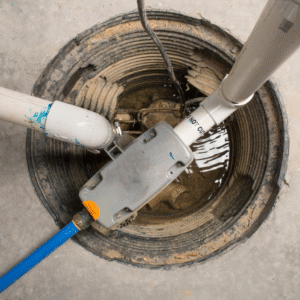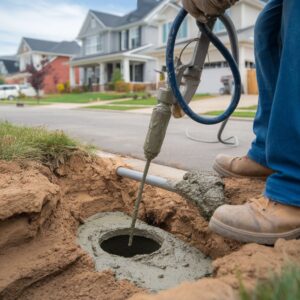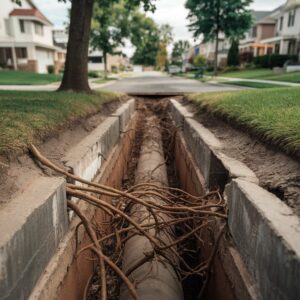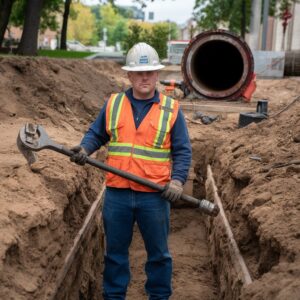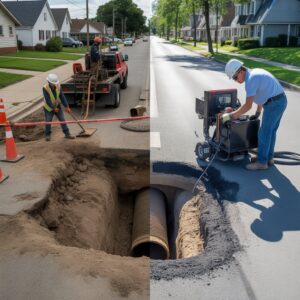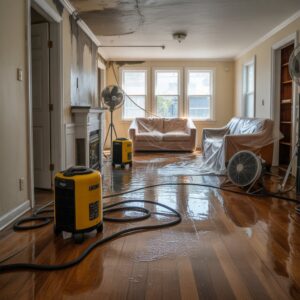Check for power supply disruptions or tripped circuit breakers if a sump pump stops working suddenly. Inspect the float switch and sump pit for obstructions. Clear any blockages in discharge lines and verify the pump is connected correctly. Test the pump’s operation by pouring water into the pit. Manual water removal may be necessary to prevent flooding if the pump remains unresponsive. Further sump pump solutions and insights into preventing future failures are available for exploration.
Key Takeaways
- Verify the power supply and circuit breaker to confirm the sump pump is receiving electricity.
- Inspect the float switch for any obstructions that might be preventing activation.
- Clear debris from the sump pit and discharge lines to ensure proper water flow.
- Listen for unusual noises or silence, which may indicate mechanical or electrical failure.
- Consider manually removing water from the sump pit to prevent flooding.
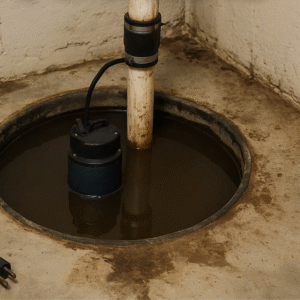
What Typically Causes a Sump Pump to Fail?
Sump pump failure can often be attributed to power outages, switch malfunctions, or clogged discharge lines, which can cause sump pump failure if not addressed promptly.
To troubleshoot effectively when a sump pump has stopped working, one must first inspect the power supply and confirm that the sump pump works properly. Ensure your sump pump receives adequate electricity and all connections are secure.
Immediate actions should include checking for blockages in the discharge pipe and evaluating the condition of the float switch to ensure your sump pump activates when needed, keeping your basement dry, and confirming it’s working as intended.
How Can I Troubleshoot a Sump Pump That Has Stopped Working?
Why would a sump pump suddenly cease to function? Identifying the issue is essential in sump pump troubleshooting. Common causes of sump pump failure include a malfunctioning float switch, a power outage, or debris in the sump pit. Begin by inspecting the float switch; verify it isn’t stuck. Confirm power supply integrity to rule out electrical issues. Clear the sump pit to restore normal water level detection if the sump pump stopped working due to debris. Reset a sump pump by unplugging and reconnecting it. Evaluate if sump pump repair or replacement is necessary based on findings.
| Problem | Cause | Solution |
|---|---|---|
| Float Switch | Stuck or jammed | Adjust or replace |
| Power Outage | No electricity | Check the power source |
| Debris | Clogged sump pit | Clean sump pit |
| Electrical Fault | Wiring issues | Inspect and repair wiring |
What Immediate Actions Should I Take When My Sump Pump Fails?
When a sump pump ceases operation unexpectedly, immediate action is necessary to mitigate potential flooding.
Begin by inspecting the pump to identify visible sump pump issues. Verify power supply continuity; if the pump doesn’t start, examine the circuit breaker and ensure the power cord is intact.
Listen for the sump pump motor; if silent, this may indicate electrical failure. Examine discharge lines for obstructions that impede flow.
If the pump is running but ineffective, troubleshoot for impeller or float switch malfunctions. Consider manual water removal to prevent basement flooding and water damage.
Schedule routine sump pump maintenance to avoid future disruptions. Swift diagnostics are essential to circumvent prolonged inactivity and preserve the property’s structural integrity.
Can a Faulty Float Switch or Power Outage Cause Sump Pump Issues?
A faulty float switch can hinder sump pump operation by failing to trigger the pump when water levels rise, leading to potential flooding.
During a power outage, sump pumps cease functioning unless equipped with a backup power source, risking water accumulation.
Regular maintenance, at least biannually, is essential to guarantee components such as the float switch remain functional and to verify that backup systems are operational.
How Does a Float Switch Affect My Sump Pump Operation?
Understanding the role of a float switch in sump pump operation is fundamental for maintaining system functionality. The float, a key component, controls the sump pump switch by detecting water levels. When water rises, the float activates the switch, prompting the sump pump to operate.
Conversely, if the float is obstructed or malfunctioning, it can lead to pump failure, causing it to stop working unexpectedly. To prevent sump pump failure, it is essential to regularly inspect and clean the float mechanism to guarantee smooth operation.
If the sump pump continues to malfunction, it is advisable to troubleshoot the sump pump’s electrical connections and mechanical components. Proper maintenance of the float switch is critical for the sump pump to secure reliable performance.
How Do Power Outages Impact Sump Pump Function?
While a properly maintained float switch is crucial for sump pump functionality, another critical factor influencing sump pump performance is the impact of power outages.
These outages can lead to sump pump failure, resulting in potential flooding. Implementing a backup battery sump pump system is essential to mitigate this risk. Such systems guarantee your sump pump continues operation when the primary power source is compromised. A backup sump pump also prevents water damage by activating when the main pump stops working.
- Install a backup battery sump pump system to maintain functionality during outages.
- Schedule a professional sump pump inspection regularly to guarantee reliability.
- Consider a generator as an additional power source for your primary pump needs.
- Confirm your sump pump isn’t the sole line of defense against flooding.
How Often Should I Perform Sump Pump Maintenance to Prevent Failure?
To prevent sump pump failure, it is vital to adhere to a routine maintenance schedule, typically involving pumping every three to four months, because it can lead to costly basement flooding and water damage.
Regular sump pump maintenance is crucial to maintain your system in good working condition. Begin by inspecting the discharge line for obstructions and verifying the check valve is functioning properly to help the pump continue to operate even during heavy rainfall.
Test the pump by pouring water into the pit, confirming it activates and drains efficiently. Monitor your sump pump for any unusual noises or vibrations, as these issues can indicate that your sump is still operating correctly.
Faulty float switches and power outages are common causes of sump pump malfunctions. To prevent problems, consider consulting a professional sump pump technician for thorough assessments and to check that the pump is reliable. Regular maintenance can also help you pump back water effectively, keeping your basement dry and extending the lifespan of your system.
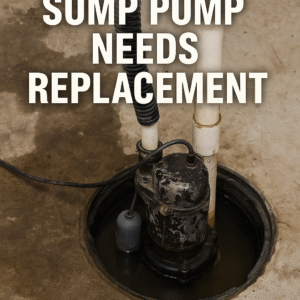
How Do I Know When My Sump Pump Needs Replacement?
A sump pump nearing the end of its operational lifespan typically exhibits indicators such as increased noise levels, irregular cycling, and reduced water removal efficiency, signaling potential failure.
Generally, sump pumps have a functional duration of approximately 7 to 10 years, beyond which performance degradation is anticipated.
Ignoring initial minor malfunctions, such as intermittent power failures or clogging, may accelerate wear and culminate in catastrophic pump failure, necessitating immediate replacement to prevent basement flooding.
What Are the Warning Signs That My Sump Pump Stopped Working?
Recognizing the indicators of sump pump failure is crucial to preventing a flooded basement. If the sump pump stops working, initial troubleshooting steps should include checking if the sump pump is still receiving power and functioning properly.
Assess the sump basin and sump pit for any anomalies. A malfunctioning pump motor may signal an impending failure. Maintaining your sump pump regularly can help detect issues and ensure your sump continues to operate efficiently.
Key warning signs include:
- Constant running: Indicates potential mechanical issues or an overwhelmed capacity.
- Unusual noises: Grinding or rattling sounds suggest internal damage.
- Vibrations: Excessive shaking during operation could mean misalignment.
- Backup system activation: Frequent reliance on a backup sump pump system may indicate that the primary pump continues to operate inadequately.
Timely intervention can prevent your sump pump from failing. Homeowners should also consider a professional sump pump technician for a thorough assessment and maintenance to safeguard their basement from costly water damage.
How Long Do Sump Pumps Typically Last Before Failing?
While sump pumps are designed to protect homes from water intrusion, their lifespan is finite. It typically ranges between 7 and 10 years, depending on factors such as frequency of use, maintenance, and quality of installation.
Sump pumps can fail due to worn-out components or electrical issues. Regular inspections and upkeep are crucial to avoid sump pump failure.
Please ensure your sump pump remains in good working condition by checking for unusual noises and regularly testing its operation. Replace your sump pump if it’s nearing the end of its service life or exhibits signs of malfunction.
Installing a backup pump is vital to guarantee continuous protection. Consultation with a professional sump pump technician can help identify issues and assure your sump system’s reliability.
Can Ignoring Minor Sump Pump Issues Lead to Major Failures?
Recognizing when a sump pump requires replacement is critical to avoiding significant water damage. Minor issues left unattended can turn into major failures, causing the sump pump to fail and cease operation unexpectedly.
A sump pump system’s efficiency depends on timely troubleshooting steps to identify any root cause before excess water accumulates. Indicators of potential sump pump failure include:
- Unusual noises: Grinding or rattling sounds indicate mechanical wear or debris obstruction.
- Inconsistent cycling: Frequent on/off cycling may suggest a faulty float switch or electrical issue.
- Visible rust or corrosion may compromise the sump pump’s structural integrity.
- Reduced pumping capacity: The inability to manage excess water leads to potential overflow.
Engaging a professional sump pump technician can guarantee accurate diagnostics and preemptive replacement, maintaining system reliability.
How Can I Keep My Sump Pump Running Smoothly?
Regular testing and error prevention are paramount to maintaining ideal sump pump functionality.
Testing involves simulating water flow to trigger the float switch and confirm operational readiness.
Standard errors, such as improper installation, clogged discharge lines, and neglect of routine maintenance, can lead to system failures, emphasizing the necessity for meticulous oversight.
How to Test Your Sump Pump to Make Sure It’s Working Correctly
Verifying a sump pump operates effectively involves systematic testing and maintenance procedures.
To test a sump pump, fill the sump pit with water to see if the pump turns on automatically. If the sump pump won’t turn on, it’s essential to investigate what causes a sump pump to stop working. Continuous monitoring guarantees the pump is still functional.
Here’s how to test:
- Simulate high water levels: Add water to the sump pit and observe.
- Check the float switch: Confirm it rises with water levels and activates the pump.
- Inspect electrical connections: Verify that the power supply is consistent.
- Evaluate the discharge line: Ensure no blockages impede water ejection.
What Common Mistakes Cause Sump Pumps to Stop Working?
After establishing the operational status of a sump pump through testing, attention must shift to understanding and preventing common operational errors that can lead to pump failure. A critical reason your sump pump may cease functioning is improper installation of the pump and the check valve. This error can cause water to flow back into the sump pit, causing the pump to run continuously. Such continuous operation can result in overheating, ultimately leading to sump pump failure.
Another prevalent issue is debris accumulation, obstructing the pump’s impeller and intake. Ensuring regular maintenance can mitigate these risks. Below is a table highlighting common mistakes and their impacts:
| Mistake | Impact on Pump |
|---|---|
| Incorrect valve installation | Water flowing back |
| Continuous running | Overheating, and failure |
| Debris accumulation | Blockage, and malfunction |
| Infrequent maintenance | Increased failure risk |
How Do I Reset or Prevent Sump Pump Failure?
For effective sump pump maintenance, it is essential to understand the impact of cold climates, which can cause discharge lines to freeze, leading to potential pump failure.
To reset a sump pump, one must typically unplug the unit, inspect the float switch for obstructions, and verify that the check valve is operational.
Preventing recurring issues in the basement involves regularly inspecting the pump’s mechanical components, ensuring the pit is debris-free, and implementing backup power solutions to mitigate power outages.
What Should I Know About Sump Pump Failure in Cold Conditions?
In cold climates, sump pump failure often results from freezing discharge lines, obstructing water flow, and leading to system malfunction.
When a sump pump stops working, the pump lid should be inspected for ice blockages. Further issues are unlikely if the pump resumes operation after thawing, but regular checks are advisable.
If sump pump failure persists, insurance coverage for sump pump failure might be considered. Engaging a professional sump pump technician can prevent recurrence.
To guarantee peak performance:
- Install a discharge line with a larger diameter to prevent freezing.
- Utilize a sump pump with a built-in heating element for colder regions.
- Verify the discharge line is adequately sloped to facilitate drainage.
- Consider a professional inspection before the pump starts each winter.
How Can I Avoid Recurring Sump Pump Problems in My Basement?
Addressing sump pump failures in cold climates is vital to maintaining a dry basement. Key strategies include regular sump pump maintenance and professional sump pump service.
Inspect the system quarterly to guarantee ideal functionality and extend the sump pump’s lifespan. Regular inspection should focus on debris removal, which can prevent the sump pump from stopping working due to clogging.
Implementing a sump pump backup system is important, especially during power outages, to mitigate potential basement flooding. Consider power outage solutions such as battery backups or generators.
Proper sump pump installation by professionals guarantees reliability and longevity. These preventative measures considerably reduce the risk of recurring issues and maintain effective water management in the basement environment.
Conclusion
To summarize, maintaining the ideal function of a sump pump requires regular inspection and understanding of potential failure points, such as float switch malfunction or power interruptions. Timely replacement of worn-out components can prevent costly water damage. Implementing routine maintenance, including clearing debris and testing the backup power system, enhances longevity. Homeowners can guarantee reliable sump pump operation and protect their property from basement flooding by resetting the system when necessary and proactively addressing issues.

